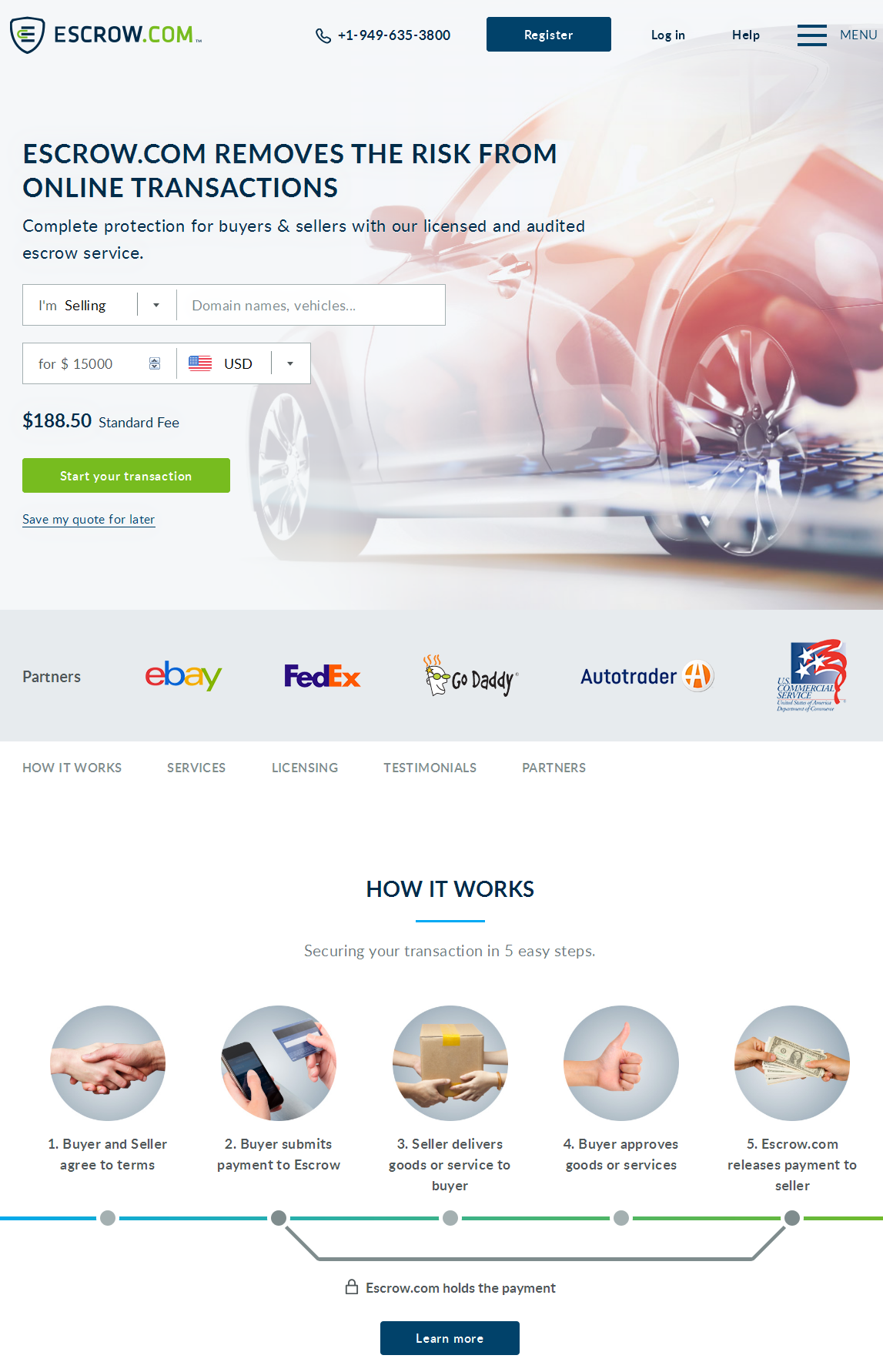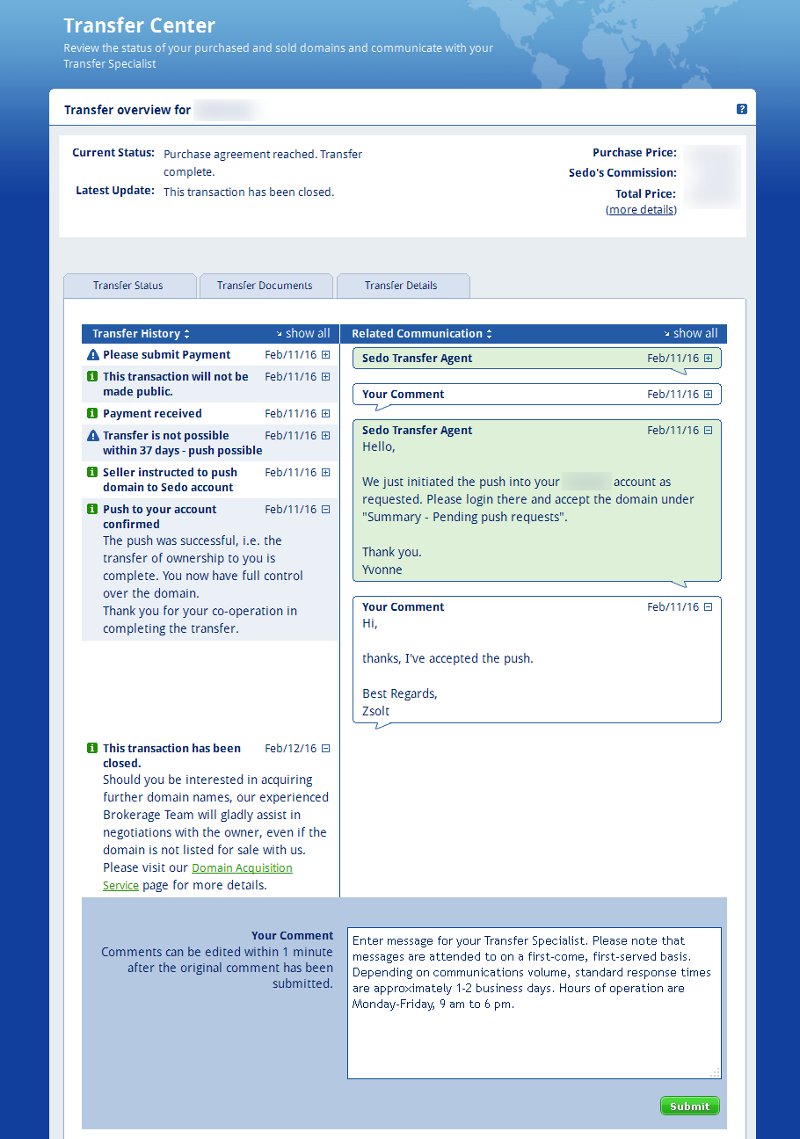So you have found the ideal domain name for your business and negotiated a price with the seller. That’s an important first step. However, you don’t know each other and therefore don’t have a complete trust although the other party looks reliable. Should the buyer pay first and the domain transferred when the payment arrived? Or oppositely, should the buyer only pay when the domain is in his/her account? This is the situation which is typical for domain transaction and can be easily managed by escrow services or a middleman. Even if you have complete trust for a reason, things can go wrong in many unexpected ways. Thus, it is always recommended to not transfer money directly to the seller or not transfer the domain directly to the buyer.
The two most common service used by domainers are Escrow.com and Sedo transfer service, we are reviewing the strengths and weaknesses of these below.
Escrow.com
Escrow.com is the largest online escrow service and they have specific features for domain name sales. Their process is the following.
- Either the buyer or seller initiates a transaction. The only thing needed from the other party is an e-mail address. During the setup, the two most important things to decide is the length of the inspection period and who pays the fees. Inspection period can be somewhere between 1 and 10 days for domain names. Since there is not much things that should be inspected when buying a domain name and all can be done in a day, more than 3 days are not recommended. Escrow fees can be paid by either party or split equally. For smaller transactions it can be relatively high, so it is important to discuss this during the negotiation process. When both parties agreed with the terms and confirmed it with a click, the transaction process begins.
- The buyer should select a payment method and send the money to Escrow. Most common payment methods like using credit card, Paypal or wire transfer are available.
- As soon as the payment arrived to Escrow, the seller will get an email notification to proceed with the domain transfer. The domain can be either pushed to another account at the same registrar or transferring away using an EPP code. Domain push is almost immediate, while transfer is often time consuming so if possible, domain push is recommended. It is important to use the buyer contact information during the domain push so there is a clear indication in the whois database that there is an ownership change.
- After the domain was pushed/transferred to the buyer account, the buyer should confirm that (s)he has a full control over the domain name. This is when the inspection period begins.
- The inspection period can be ended by the buyer by confirming that the domain is controlled and there is no problem with it. After the end of the inspection period, it is automatically confirmed.
- When the domain is accepted by the buyer, the seller will get the payment from Escrow using the requested payment method within a couple of days.
How can things go wrong?
In most cases the previously described ideal process happens but when everything goes fine, there is no need for escrow services at all. The main strength of the middleman to handle situations when things go wrong. Let’s see some typical issues.
- Buyer does not pay. No problem, the transaction will be canceled due to inactivity.
- Seller does not deliver the domain. No problem, the buyer will get back the money minus the escrow fee.
- The domain is transferred but the buyer does not confirm the delivery. This is the nightmare of the sellers. In this case the seller has to start a dispute and needs to prove the delivery of the domain. Proving the delivery is not always easy, since buyer can whoisguard the domain or fake the whois contacts. It is advisable to capture a video about the domain transfer process to have a delivery proof. If there is no such a proof, the Registrar should be contacted to provide a proof of the push or transfer. However, they will be only able to prove that the domain was transferred out but cannot prove that the domain was transferred to the buyer. Domain push is more secure, since it can be reverted by the registrar and the registrar has information about the recipient identity. Based on the provided evidences, Escrow.com will decide to release the money to the seller or refund the buyer.
- The domain is not transferred but the seller states it is transferred. Like the example above, the seller has to prove that the domain is transferred to the buyer in a dispute. Buyer is in more secure position, since the seller will not be able to prove the delivery if it is not really delivered.
As the above two examples described, there can be situations when Escrow.com is not hundred percent safe for the sellers or at least difficulties arise. Realizing this issue, Escrow.com has introduced a concierge service, which is an optional addition for domain name transactions. Using this service, the domain will be transferred to Escrow.com and not the buyer, and Escrow.com will push the domain to the buyer when the payment has been made. This way the transaction is 100% safe and secure.
Fees
3.25% between 0 and $5000 ($25 minimum); 0.89% over $25,000 and $162.5 + 0.25% between those. Additional $30 if payment is made via credit card. The concierge service costs an additional $100. There is a $40 wire transfer cost of the seller.
Sedo external domain transfer service
Sedo’s domain transfer service is similar to Escrow’s concierge service. Namely, there is a middleman (Sedo) who receives both the payment from the buyer and the domain from the seller. When they received both, they will transfer the domain to the buyer and money to the seller. This transaction is 100% safe and very fast. Interestingly there is no online form to start such a process but the seller (or buyer) should write an email to Sedo with the details of the transaction. Sedo will prepare the necessary links within a day and the process is automated from that time and can be monitored in transfer center.
Fees
External domain transfer service has a 3% fee ($60 minimum).
Conclusion
Domain transactions are 100% safe for both buyers and sellers using appropriate services. Escrow concierge services and Sedo external domain name transfer service provide practically the same security and services, both are recommended. Below $5000 sales price Sedo service is cheaper. Since it is 100% secure and very fast, it is recommended for such transactions. Above $10,000 Escrow.com is cheaper even with the concierge service so Escrow.com is recommended for more expensive domains.


